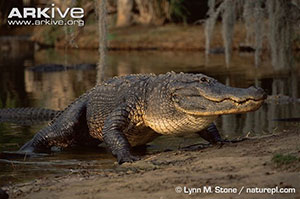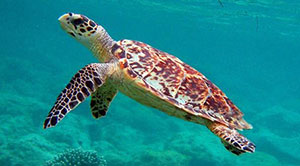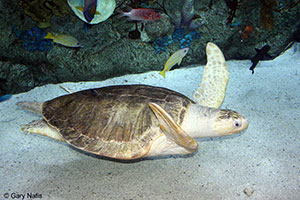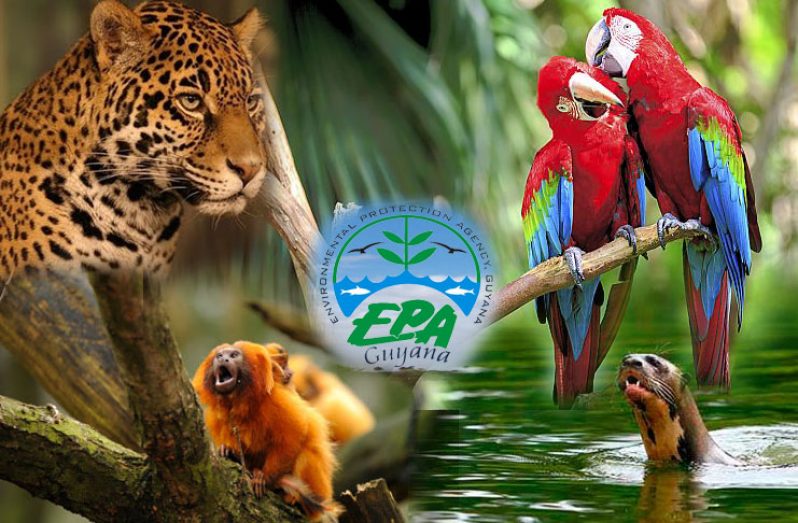This week we continue our series on protected animals of Guyana by putting the spotlight on reptiles. Often viewed as scary, reptiles do not enjoy the popularity of attractive birds, butterflies or fish. But reptiles are an important link in nature’s food chains and are needed to
maintain its balance in the environment. Read on, and no doubt you will change the way you think of reptiles.
Why protect Reptiles?
Reptiles are usually considered as hardy and difficult to injure or penetrate. However, they are vulnerable to a number of threats. Since reptiles have inhabited the Earth for more than 250 million years, they are adapted to many habitats. However, they are not usually perceived as the most charming and thus may have been overlooked for conservation efforts. Yet, with only one third of described reptile species evaluated, the IUCN (International Union for the Conservation of Nature) Red List of Threatened Species comprises about one third reptile species! This means that many of the known reptiles are threatened.
Main Priority for Conservation: Protect the Habitat
Ultimately, the key to protecting reptiles is to conserve natural habitat. Some small species might be able to persist for decades on a few acres of disturbed woodland, but larger species that occupy the top levels of the food chain require the protection of thousands of acres to maintain viable populations.
Conservation efforts for species with complex life cycles must protect the full range of habitats required by all life stages. For example, many freshwater turtles need cover, basking sites, and feeding and nesting areas. Conservation efforts need to ensure that habitats are connected to avoid the consequences of isolation and habitat fragmentation and shredding.
Protected Reptiles of Guyana
Here are some quick facts about Reptiles under legal protection in Guyana.
BLACK CAIMAN (Melanosuchus niger)
This impressive aquatic hunter is the largest of all alligator species, with reports of individuals measuring six metres.
The black caiman superficially resembles the American alligator.
These night hunters have acute sight and hearing to locate their prey.
Most adults are 2.8 – 4.26 m (9.2-14 ft) in length, with a few old males growing larger than 5 metres (16 ft) and exceeding a weight of 400 kg (880 lbs).
LEATHERBACK SEA TURTLE (Dermochelys coriacea)
Leatherback sea turtles are the biggest turtles on Earth.

Unlike other species of sea turtles, which have hard shells, the leatherback’s shell is leathery; it feels almost rubbery.
According to Scientists, these huge reptiles lived 100 million years ago, during the dinosaur age but their future remains uncertain amidst the numerous threats.
Only female Leatherbacks leave the ocean, they breathe air at the surface, but can stay underwater for up to 35 minutes at a time
HAWKSBILL TURTLE ((Eretmochelys imbricata)
Generally smaller in size compared to other turtles, hawksbills grow up to about 45 inches (114 centimeters) in shell length and 150 pounds (68 kilograms) in weight.
They get their name based on the fact that their head ends end in a sharp point resembling a bird’s beak.
A further distinctive feature is a pair of claws adorning each flipper. Male hawksbills have longer claws, thicker tails, and somewhat brighter colouring than females.
Hawksbills are omnivorous and eat mollusks, marine algae, crustaceans, sea urchins, fish, and jellyfish. Their hard shells protect them from many predators, but they still fall prey to large fish, sharks, crocodiles, octopuses, and humans.
GREEN TURTLE (Chelonia mydas)
Green sea turtles are the world’s largest species of hard-shelled sea turtle. While most

individuals weigh about 300 to 400 pounds (136 to 181 kilograms), some can be as heavy as 440 pounds (204 kilograms).
Adult green sea turtles eat a primarily plant-based diet consisting of seaweed and sea grass.
Similar to other sea turtles, green sea turtles migrate long distances between their feeding grounds and their nesting sites, with recorded distances longer than 1,615 miles (2,600 kilometers).
GIANT SOUTH AMERICAN TURTLE (Podocnemis expansa)
The giant South American turtle is the largest river turtle in South America.

The giant South American turtle nests during the low water season, laying from 75 to 125 leathery eggs per clutch.
The gender of the hatchlings is determined by the average temperature at which they are incubated; females develop at higher temperatures and males develop at lower temperatures.
The giant South American turtle inhabits freshwater rivers with sandy banks or sandbars, which are crucial for nesting.
PACIFIC RIDLEY TURTLE (Lepidochelys olivacea)
The Pacific Ridley Turtle, also known as the Olive Ridley Turtle due to the greenish colour of its skin and shell, has an average life span of 50 years in the wild.

Males can be distinguished from females by their tails, which stick out beyond their carapace.
This turtle is mostly carnivorous, feeding on such creatures as jellyfish, snails, crabs, and shrimp but will occasionally eat algae and seaweed as well.
For a complete list of protected species in Guyana, have a look at the Wildlife Management and Conservation Regulations that can be found on the Agency’s website at www.epaguyana.org.
Sources
•http://www.theecologist.org/News/news_analysis/1828426/a_scaly_crisis_why_we_must_act_now_to_save_reptiles.html
• https://ssarherps.org/conservation/protect-habitat/
• http://kids.nationalgeographic.com/animals/green-sea-turtle/#green-sea-turtle-closeup-underwater.jpg
• http://www.arkive.org/giant-south-american-turtle/podocnemis-expansa/
• http://animals.nationalgeographic.com/animals/reptiles/olive-ridley-sea-turtle/



.jpg)











